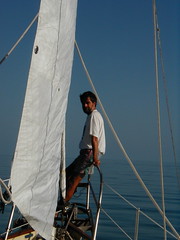Our summer sailing region ... one of it. The 1000 Islands, a short run East of Kingston.
The Thousand Islands are a chain of islands that straddle the U.S.-Canada border in the Saint Lawrence River as it emerges from the northeast corner of Lake Ontario. The islands stretch for about 50 mi (80 km) downstream from Kingston, Ontario.
The Canadian islands are in the province of Ontario. The U.S. islands are in the State of New York. The islands, which number 1,865 in all, range in size from over 100 km² to smaller islands occupied by a single residence, to even smaller uninhabited outcroppings of rocks that are home to migratory waterfowl. The number of islands was determined using the criteria that any island must be above water level for 365 days per year and support at least one tree or shrub.
The area is rich in history - it was a favourite hunting ground of the Iroquois before European exploration, with immigrants travelling along the river and up to the northern lakes in the 1700s and early 1800s.
http://www.thecanadianencyclopedia.com/index.cfm?PgNm=TCE&Params=A1ARTA0007992And with railways built subsequently, tourism arrived at the shores of the 1000 Islands.
Still, the area is home to both: cargo transport via the St. Lawrence Seaway, and individual exploration; at times, pleasure boaters and cargo vessels join the same waters in very close proximity.




